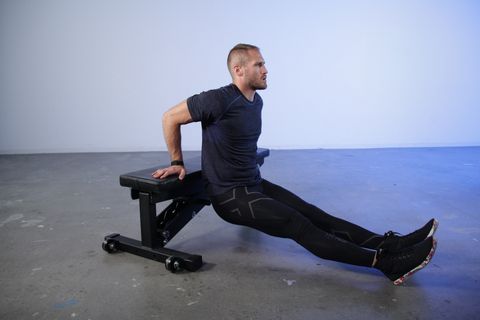The bench dip is a valuable addition to your training routine that can help to pump up your triceps, but are you sure you’re even doing the exercise correctly?
For this movement, you shouldn’t settle for anything other than perfect form—especially because it’s such a killer exercise that can serve as a highlight of your training plan. Let Men’s Health fitness director Ebenezer Samuel, C.S.C.S. and associate fitness editor Brett Williams guide you through the move’s subtleties, saving you from the bad habits that are keeping you from unlocking your fitness potential.
Before you hit the bench and start pumping yourself up and down, take note that it’s extremely important to pay attention the movement here. Hitting the proper form is essential to make sure you’re getting the most out of the exercise—particularly because of the subtle details with the right hand placement and shoulder position that make it really effective. Let’s break down everything you need to know.

Men’s Health
Know Your Body
Eb says: The dip is a solid move to pack on triceps muscle, but it also places the shoulders in a compromising position, inviting a ton of internal rotation at the shoulder joint. This closes down joint space in the front of your shoulder, easily pinching the many tendons and ligaments that travel through that area.
That doesn’t mean you can’t do dips, but before you attempt them, check out your body and your mechanics. Reach your straight arm behind your torso as far as you can and see how high you can get your elbow. If you can’t get it level with your shoulder (and it’s completely okay to not be able to do that), you should be extra-conscious of not lowering your torso too far when you do dips.
Knuckles Out
Eb says: Because the dip invites so much internal rotation, we want to set ourselves up in a position that forces as much shoulder external rotation as possible. That’s why you shouldn’t get in the bench setup that most people use, with knuckles pointed forward.
Instead, point your knuckles outwards. This mirrors how you’d set up your hands on dip bars, and creates a more shoulder-safe position.
Scaps Squeezed and Tight
Eb says: Before you do a rep, squeeze your shoulder blades together, then push your torso up high. Again, we’re working to avoid as much shoulder pinching as possible, so pulling your shoulder blades back will help drive your shoulders open and also open your chest in the process.
You’ll want to maintain this scapular tension as you lower into the dip, fighting for it as you’re pressing down. The moment you can’t hold that scapular tension is the moment you stop lowering your torso.
Personal Depth
Eb says: The main triceps function we train with the dip is the straightening of the arm (extension of the elbow), and that occurs when you straighten the arm, not when you bend super-deep. So lowering your torso deeper on the dip doesn’t work your triceps “more”; it just creates a potential mechanism for injury. Because of that, don’t over-lower. Stop lowering the moment you can’t keep your shoulder blades tight or the moment you feel shoulder pain, then drive back up, straightening your arms aggressively.
Shoulder mobility is highly personal so your depth on the dip will be personal as well. Don’t chase an arbitrary standard. The only thing you don’t want to do: Never net your shoulders get lower than your elbows, because then you’re putting your shoulders at serious injury risk.
Find Other Tools
Eb says: The dip is a tried-and-true triceps exercise, but it’s not for everyone, and there are plenty of other ways to stimulate major triceps growth. If you have shoulder issues, this is a move that you may want to sit out, period, even if a group fitness trainer wants you to do it, or if it’s in a workout plan you’ve decided to try.
Don’t be afraid to sub it out. Exercises like close-grip pushups, skullcrushers, and triceps pressdowns all offer chances for you to grow your triceps with less shoulder risk, so don’t obsess over the dip.
Want to master even more moves? Check out our entire Form Check series.
Source: Read Full Article
